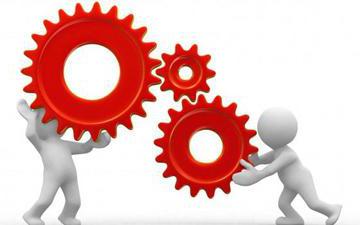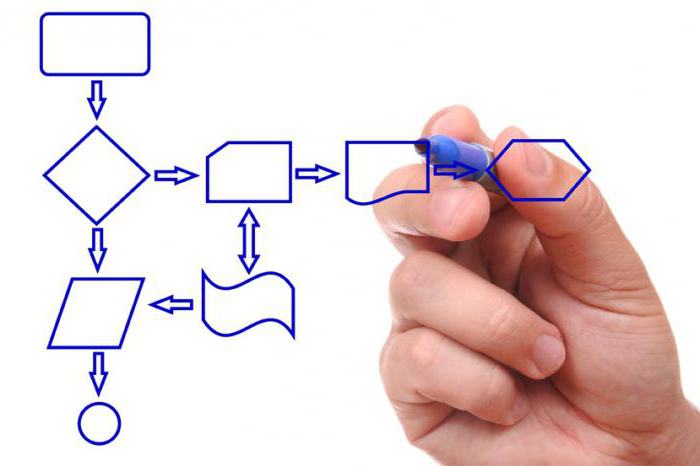In order to survive in fierce competition, it is vital for a modern company to quickly respond to market changes and make rational use of available resources. However, over time, efficiency decreases - part of the actions and procedures become obsolete, departments begin to duplicate each other's tasks. That is why timely audit of business processes is so important. Knowing the weaknesses of the enterprise, management can take appropriate measures and optimize the work. 
Definitions
A business process is a chain of logically connected, periodically repeating operations during which the organization’s resources are used to process an object (virtually or physically). In other words, this is a certain segment of the enterprise’s work with real, measurable results.
An internal audit of business processes is an analysis of all types of company activities: production, commercial, social. Its task is to determine how effectively the main structural units of the company and the channels of information transfer function. 
When to spend
1. After the introduction of new documentation and instructions. For example, when installing other software. In this case, it is better to conduct an audit not immediately, but after a while, necessary for the “break-in” and testing. The depth of verification depends on the magnitude of the changes and the importance of this process for the company.
2. Scheduled audit. It is carried out according to the established schedule, at least 1 time per year.
3. Unscheduled audit. It is organized at the request of senior management or the manager responsible for a specific business process. Such a need may arise if:
- a major malfunction occurred;
- complaints from process clients (external and internal) are periodically received;
- There are suggestions and ideas for improving the process.
Summarizing, we can say that the audit of business processes is necessary in all cases when any changes occur in the company. 
Types of business processes
In modern management theory, the division of processes into main and auxiliary is generally accepted. The first group includes everything that allows an organization to earn money and achieve certain goals:
- production of goods / provision of services;
- marketing and sales;
- logistics and delivery service;
- communication with suppliers and intermediaries;
- tax accounting;
- customer support.
Supporting, in turn, are those processes that ensure the implementation of the core, provide the necessary resources and information. These are internal functions, such as personnel management, accounting, and ensuring the safety of an object. 
Business processes: examples and description
It is important to note that each specific company has its own list of business processes, taking into account its size and specifics of activity.
The main elements of any PSU include:
- input data;
- resources (people, equipment, infrastructure, software);
- criteria (customer requirements, standards, laws);
- documents and records (payments, applications, orders, receipts, invoices);
- output data (product, its part, or necessary information);
- measurement of results (audit, monitoring, analysis).
In addition, each process must have a designated owner responsible for the end result.
Let's see how business processes can be described. We took examples from two completely different spheres in their essence.
The first company is selling franchises.In her work with clients, 4 main business processes can be distinguished. In turn, each of them consists of several operations.
- Qualification. Task: process the application. This stage allows you to create a funnel and evaluate the effectiveness of marketing. The employee processes the received application and transfers it to the status "Qualified" or "Refusal". All qualified applications immediately fall into BP-2.
- Sale. Tasks: to make a presentation, to work with objections, to receive a contribution and to transfer the project to the curator. To improve work efficiency, a system of employee motivation, a plan and a sales forecast are being developed. Transactions automatically come from BP-1 or are created manually by the manager. After the transfer to the curator, the project goes to BP-3.
- Launch. Tasks: appointment of a curator, start of work and preparation of a report. This business process provides a step-by-step franchise launch. New functions are added: document fixing, notifications to customers, attracting new employees and contractors.
- Royalty. Task: on time to receive a contribution (Royalty). Immediately after the launch, a new business process is automatically created and the date of the next payment is assigned. A franchisee support plan is also being drawn up.

The second example is a full-cycle advertising agency that produces printing products, outdoor advertising, self-adhesive materials, as well as hotel accessories. Here are 3 basic processes:
- Search. It is necessary to find potential customers, establish contact and arrange a meeting. Additionally, you need to find out where the client came from (from the database, the Internet or other sources), the scale of the planned campaign (in thousand rubles), and, if necessary, the reasons for the refusal.
- Sale. Upon request, a commercial proposal is sent, then an invoice is issued. The form of payment is indicated (100%, postpay, letter of guarantee). Then the order goes into production (BP-3). After shipping and receiving feedback, the main goal is to make the maximum number of repeat sales.
- Production. Upon receipt of the order, the production manager confirms the deadline (deadline). Technological operations are performed - prepress, printing, post-press processing. If the client is satisfied with the result, the project returns to BP-2, otherwise it returns to the beginning of the process for revision.
It is most convenient to depict the company's business processes in a schematic form, showing the main connections between them (for example, the transition from the first presentation to the sale stage). You can also provide information in table format:
Process code | Main functions and tasks | Interaction (No. of structures, units) | Way of interaction | Inbound / Outbound Documentation Codes | Control (name of the person responsible for the process) |
Documentation
The audit consists of the following key positions:
1. The order of conduct. This document is approved by senior management and contains information on the reasons for the audit (planned / unscheduled), goals, facilities, members of the commission. The Audit Manager is immediately appointed, as well as the terms for the development and approval of the program.
2. Working documents of auditors. This includes all the notes that auditors make during the audit, as well as completed questionnaires, survey results, interview forms, tests, etc. In addition, the company stores regulatory documents that specify the requirements for working documents. They should contain:
- date and place of compilation, name of inspector;
- sources and methods of obtaining information (interviews, observation, questionnaires);
- detailed description of the studied business processes;
- results of all previous audits.
Working documents are filled in both in an arbitrary and in a pre-established form - for example, in the form of tables, graphs, text, etc.
3. The audit plan. It includes several main sections: collecting and summarizing information, conducting in-depth analysis, conclusions, developing proposals and recommendations, compiling a report and presenting the results. At the beginning of the audit, its purpose, a description of the investigated business processes, as well as the stages and main verification activities are indicated. For each stage, it is necessary to determine key tasks, methods for collecting and analyzing data, deadlines, resources and those responsible for the result.
4. Report. This document summarizes the work done, identifies the strengths and weaknesses of the enterprise. The first section provides general conclusions, and the second contains detailed information on the resources expended and the results.
5. Auditor's report. Displays the most important findings and recommendations for optimizing business processes. 
Members
Depending on the complexity of the organization, its structure, the number of employees and the specifics of the business, it depends on who will conduct the audit. Consider the required participants in the audit.
- Initiator and person approving the audit. As a rule, this is one of the leaders of the enterprise or their deputies.
- Audit Commission. Mandatory requirements for participants - higher education and work experience of at least a specified period.
- The head of the commission. This position is assigned to employees of one of the independent divisions of the company (departments that are directly subordinate to the owner of the enterprise and do not participate in the main business process - security service, strategic development service, etc.). Sometimes third-party experts are involved.
- Audited persons. They can be any employees of the organization who have the information necessary for verification.
In reputable companies often create special commissions to control the audit. 
Order of conduct
The audit of business processes is carried out in accordance with clearly defined requirements. The main business cycles of the company are investigated - supply, production, sales, investment (investing in modernization and expansion), as well as management.
Stage 1: Studying the General Patterns
Internal audit begins with the collection of basic information about the activities of the enterprise, its structure and the activities of units. Basically, it is obtained from the documents of the enterprise - a strategic plan, management rules, job descriptions, codes, etc. All data is entered into the report, which indicates:
- organization structure;
- list of key business processes;
- description of the work of units: names, functions, incoming and outgoing documents, results of activities.

Often, after reporting, interviews are conducted with staff. This allows you to detect inaccuracies in the early stages, to see the difference between the real state of things and how employees themselves represent the organization.
Stage 2: Detailed Business Process Analysis
At this stage, it is necessary to describe the sequence and features of various operations in the enterprise. For convenience, tables are compiled that describe each business process individually.
Operation Name | The initial data from the receipt of which the business process begins. |
Documents, references, inquiries, etc., required to complete a task. Their sources. | |
Documents and reports that are filled in during the work. | |
Participants in the business process: company employees, suppliers, customers. | |
Materials and other resources that are used in the performance of the function and are obtained as a result. | |
The significance of the process in the work of the unit (“A” - the most important, “B” - medium, “C” - insignificant). | |
What problems arise during execution? On whose side are employees, customers, related departments? How critical are they? How do they affect cost, time, quality? | |
The timing of the process. | |
Sequencing. |
In addition, detailed diagrams and activity charts are compiled that reflect the organizational structure of the company, the sequence of work instructions, interactions between employees of the same department and different departments. The entire procedure should be documented. If possible, it is recommended to organize audio and video recordings. 
Stage 3: Modeling
The purpose of this stage is to systematize information about the company and its processes in visual graphic form. The model should show the structure of business processes, the features of their implementation, as well as the sequence of workflow.
First, a structural model is prepared that displays the interaction of departments, documentation, the structure of business processes (from general groups to private tasks). In addition, it shows how data, resources and documents are moved between the main participants.
The finished model is consistent with architects, leading programmers and specialists of the organization.
At this stage, a detailed workflow scheme is developed. For this, each document is assigned its own unique registration number / code. In a simplified form, it looks like this:
№ | Title | Where does it come from | Where to go | Information used when filling out the document | What actions are performed with the document | Responsible (full name of the employee or the name of the department). |
If during the inspection any deviations are found, it is necessary to clearly establish their cause. It can be either external or internal, objective or subjective (for example, low employee motivation).
Stage 4: Preparation of the report and presentation of the results
Based on the information received, the commission should develop recommendations and suggestions for improving processes. In this case, it is necessary to answer key questions:
- What negative side effects can I encounter?
- Do I need to update all the documentation?
- How long will it take to see the effect of the changes?
Next, the manager prepares a report and conclusion, as well as a presentation of the results. Thus, the audit of business processes allows company owners to learn about the "weaknesses" and problems in the organization. At the same time, the point of view of 2 sides is taken into account at once - verifying and verifiable.
Improvement and development of business processes may include measures for additional training of employees, software development, proposals for the promotion of personnel and personnel changes. 
Audit methods and sources of information
Starting a business and any significant changes in the enterprise require the use of the most accurate and reliable information. These are mainly mathematical predictions, comparison and recalculation of data. The data sources are documents:
- estimates, work execution logs;
- documents for placing orders;
- supply contracts;
- invoices;
- cards for calculating the cost of production;
- inventory cards;
- accounting registers;
- reports on the arrival and issue of material resources, warehouse accounting cards;
- bank statements, credit / debit cash documents, etc.
It is also necessary to collect information about the process indicators - not only the exact values, but also how the calculated values are calculated, what measures are taken in case of deviations. These data can be obtained in the process of monitoring the progress of work, as well as in interviews with employees, customers and suppliers. 
Key Performance Indicators
Depending on the purpose for which the audit of business processes is carried out, various criteria and assessment methods are used.
Field of activity | Indicators |
Finance (F) |
|
Relations with customers and customers (S) |
|
Internal business processes (B) |
|
Training and Organization Improvement (O) |
|
Using a balanced scorecard, you can immediately see in which areas of work problems arise. The most difficult period in this regard is the start of a business, when there is nothing to compare indicators with. That is why many young companies engage outside experts in the audit who can assess potential risks long before they seriously interfere with the work of the enterprise.